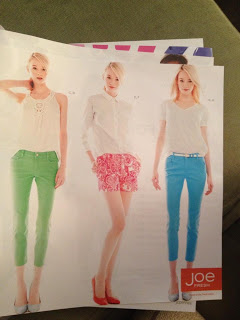Friday, on Facebook, a friend posted this ad from the JC Penny circular. This particular image comes from the company Joe Fresh. Her comment “jumping off the page is a young girl whose legs look like someone from a concentration camp. I AM APPALLED THAT COMPANIES ARE ADVERTISING WITH MODELS OF THIS SIZE. It sends an unhealthy message to our girls.”
My initial reaction was that she let the company know. As popular as shock value is, I cannot imagine that was Joe Fresh’s intention in their efforts to sell jeans. Throughout the day, as I thought more about this, my opinion changed and I reposted. “While these women are super skinny, I wonder why we harp only on the weight of models sending the wrong message. What about the fact that they are gorgeous-er than us? These are not meant to be average women any more than an NHL star in an SI add is an average athlete, hmn.” Sure, being a professional athlete isn’t a dangerous aspiration but it’s still unrealistic. Yes, I like it when ads are relatable but a teenage, rail-thin, wrinkle less model isn’t relatable for more reasons than weight.
Someone else added:
Imagine if they were obese. Would we be irate? Probably not. We might be confused or surprised but not irate. And we should be because [and yes, I just watched Weight of the Nation] that is an equally unhealthy message to send to our kids.
We are undoubtedly influenced by the media; this has been confirmed by research. Images can stoke insecurity. I just don’t believe media messages “give” us eating disorders anymore than they give us obesity. Do I like a Coke commercial? No, I would much rather a “water” commercial. Fortunately, though many discussions, my kids now know all about soda, the awful ingredients and intentions via advertising to make us want to buy it.
Eating disorders are yucky, scary and complicated. “Thinspiration” exits but it’s only one of dangerous arenas luring children. When I have sessions with eating disordered clients we spend way more time talking about their families and their friends, comments others make and emotional triggers than we do ads. I recently read the children are more receptive to conversations about weight and health when teenagers dole out the advice. I see that as a way to make inroads in this conversation with young people about body image and the media, about what’s realistic and about what isn’t.
And there’s the other “modeling”, are we modeling healthy eating habits, positive self talk and balance to our daughters and sons? Are we asking them about print ads, billboards and commercials? The newspaper circular can be a teaching tool. Which photos do you like? What do young people see when they look at the image above (and others)? If they were making it or “the boss” would they change anything? And these questions are equally important for male and female children. Boys need to know that these girls above are not “average”. We need to control what we can control because whether it’s a fast food commercial or a stick thin model, the images are here to stay.
What do you think about the ad above and others like it? What do you think is the answer to all of this?


